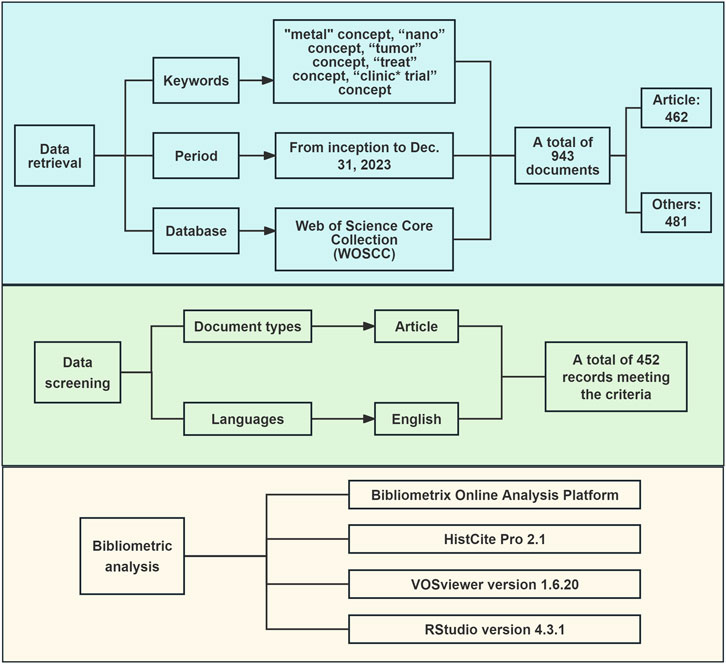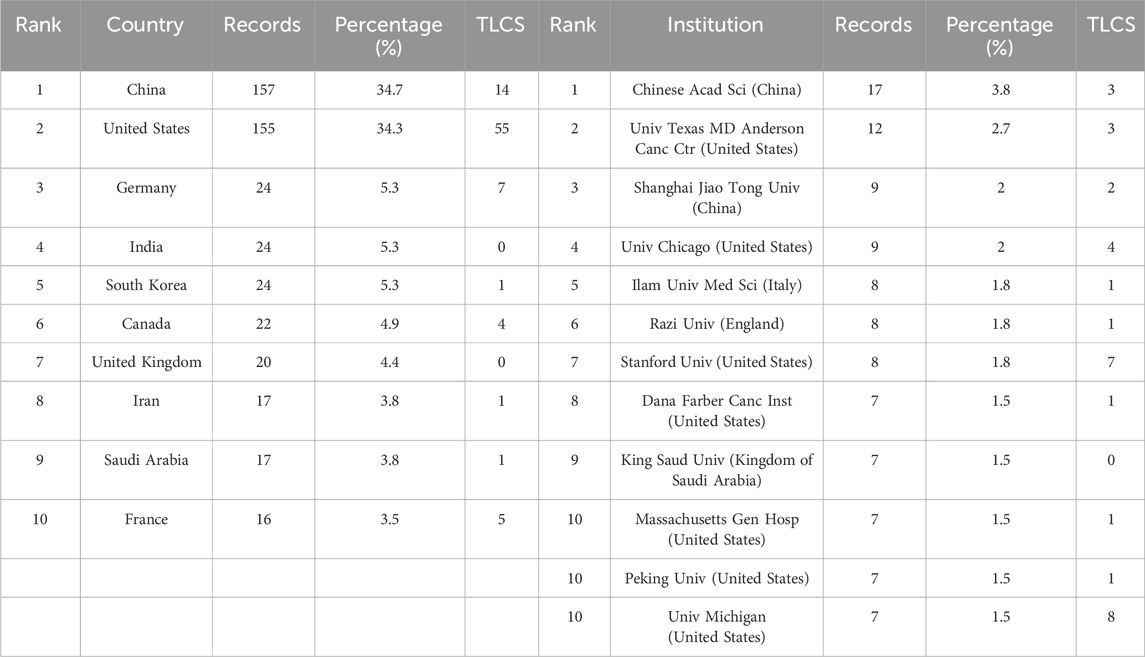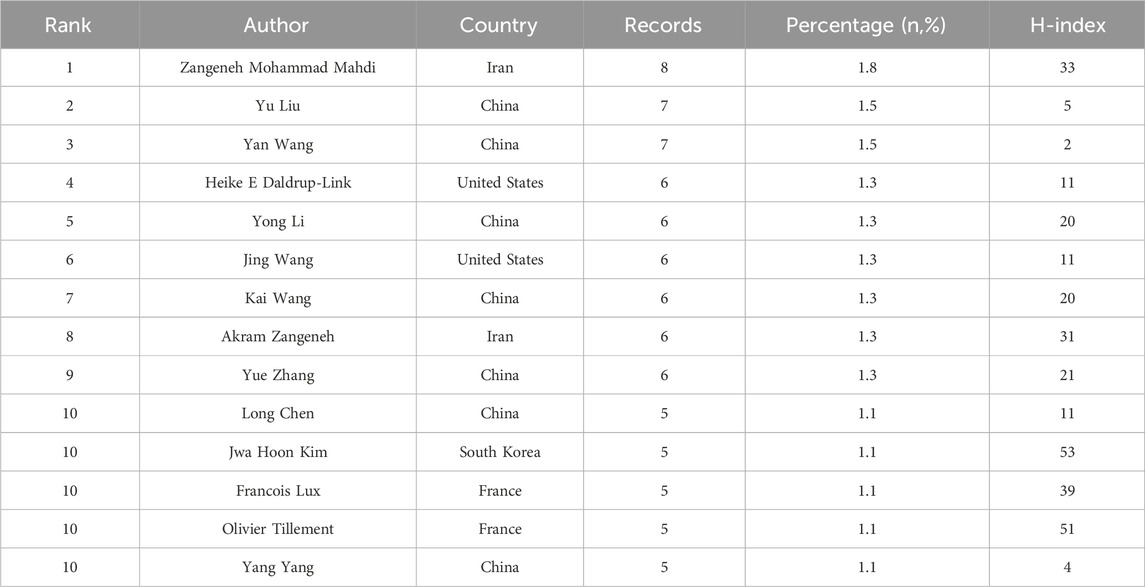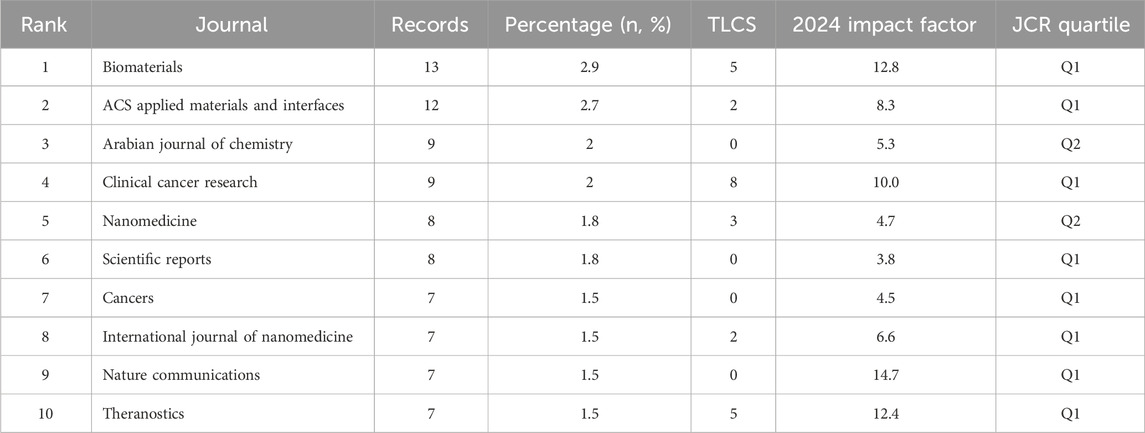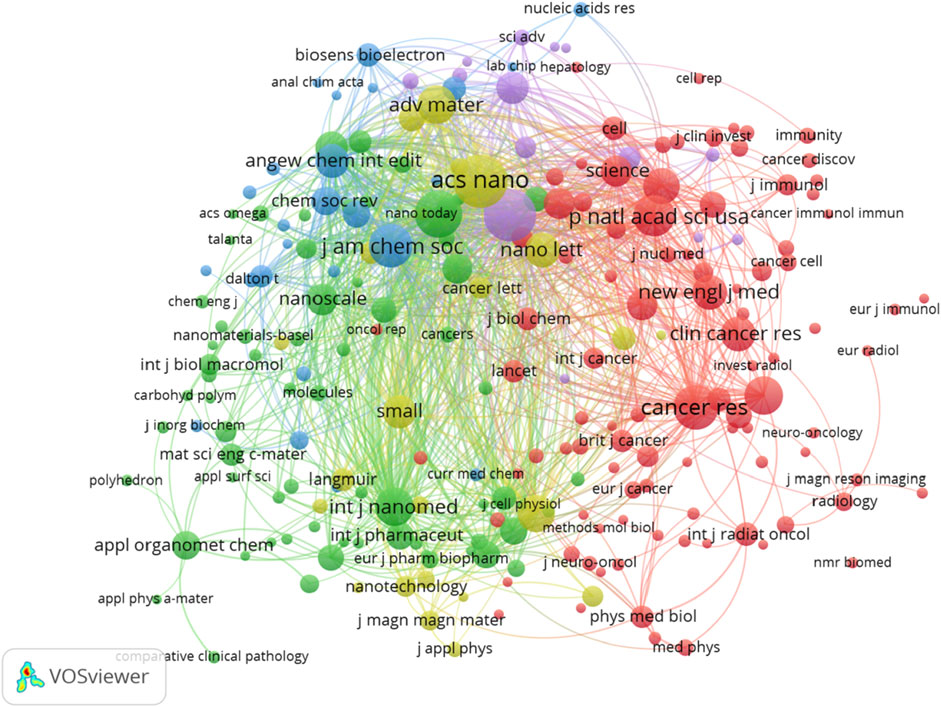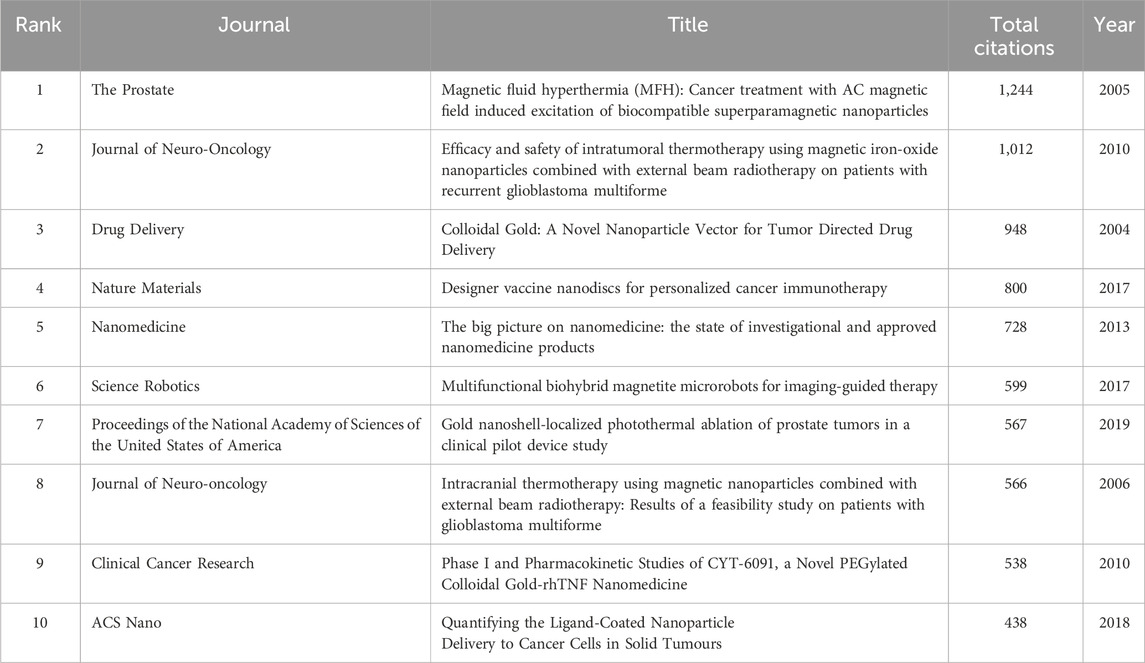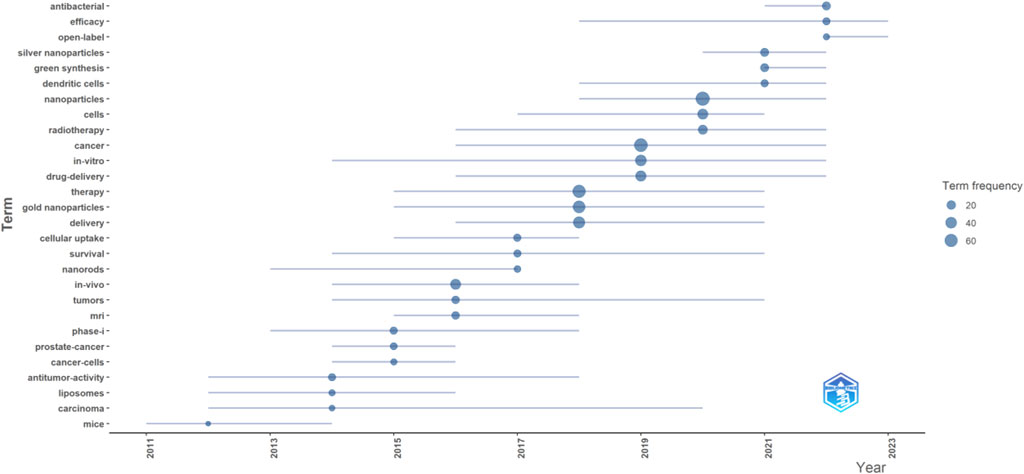- 1Nurturing Center of Jiangsu Province for State Laboratory of AI Imaging and Interventional Radiology, Department of Oncology, Zhongda Hospital, Medical School, Southeast University, Nanjing, China
- 2The Seventh Clinical College of Guangzhou University of Chinese Medicine, Shenzhen, China
Background: Cancer is recognized as a major public health problem worldwide, which brings a large number of deaths and serious economic burden. Traditional cancer treatments generally have problems such as limited application, large side effects, and drug resistance. With the rise of nanomedicine technology, its unique advantages in precision drug delivery, imaging sensitivity, assisted drug release, and enhanced drug properties have brought new hope to cancer patients. These therapies, including photothermal therapy, drug delivery, and immunotherapy, use various nanoparticles such as gold and iron-oxide to improve targeted treatment and reduce side effects. The increasing interest in sustainable NP production and safety concerns has driven new research into biocompatible and eco-friendly methods. This study aims to analyze the current research status and global trends in cancer therapy using nanoparticles through a bibliometric analysis.
Methods: The Web of Science Core Collection database was searched for publications related to NP-based cancer therapies from January 1995 to December 2023. A bibliometric analysis was conducted using using Bibliometrix Online Analysis Platform, HistCite Pro 2.1, VOSviewer version 1.6.20 and RStudio version 4.3.1, covering metrics like the number of publications, citations, countries, institutions, journals, authors, references, and keywords.
Results: A total of 452 articles published in 233 journals. The number of publications on clinical cancer therapy with metal Nanomaterials has shown consistent annual growth. China and Chinese Academy of Sciences were the leading country and institution contributing to this field, respectively. The most prolific author was Zangeneh Mohammad Mahdi, and Biomaterials was the most prolific journal. Key research hotspots identified include keywords such as “gold nanoparticles”, “delivery”, “drug delivery,” “green synthesis,” and “cytotoxicity.”
Conclusion: This is one of the first studies to perform a bibliometric analysis and visualization of publications onclinical cancer therapy with metal Nanomaterials, offering valuable insights for researchers. Future studies should focus on enhancing the efficacy, biocompatibility, and sustainable synthesis of nanoparticles, with an emphasis on their use in personalized medicine and photodynamic therapy.
1 Introduction
Cancer is a globally recognized major public health problem. According to global cancer data released jointly by the International Agency for Research on Cancer and the World Health Organization (WHO), the number of new cancer cases worldwide in 2020 is expected to be 19.29 million, and the number of new deaths is expected to be 9.96 million (Sung et al., 2021). The incidence of cancer is significantly higher than that reported in 2014 (Torre et al., 2015). According to the study, there will be 28.4 million new cases in 2040, an increase of 47% over 2020, and the global cancer burden will be further aggravated. At the same time, cancer causes a high level of mortality. Globally, 3 out of every 10 premature deaths from noncommunicable diseases are reported to be caused by cancer (Bray et al., 2021). Cancer not only threatens human life and health, but also brings a huge burden to the global economy. According to one study, the global economic cost of cancer from 2020 to 2050 is estimated to be about US $25.2 trillion, equivalent to an annual tax revenue of 0.55% of global GDP (Chen et al., 2023). In summary, cancer poses a great challenge to human health, social economy and healthcare systems worldwide (2020). Surgery, radiotherapy and chemotherapy have always been considered as the three pillars of cancer treatment. However, these treatment measures have problems such as limited scope of application, drug toxicity and more discomfort symptoms.
In recent years, researchers have been committed to exploring new measures for effective treatment of cancer, such as immunotherapy, tumor vaccination, stem cell therapy, photodynamic therapy and other treatment measures. With the rise of nanotechnology, and its unique advantages in precise drug delivery, imaging sensitivity, assisted drug release, and enhanced drug properties have attracted extensive attention from researchers (Rytov et al., 2022). It is noteworthy that the great progress made in the field of nanomedicine provides a potential alternative treatment for cancer. Nanomaterials refer to particles with a size of less than 100 nm, including three types: organic, carbon-based and inorganic. Inorganic Nanomaterials are mainly composed of metals, metal oxides and semiconductor materials (Villalobos Gutiérrez et al., 2023). Among them, metal Nanomaterials have become promising nanomaterials for cancer treatment due to their high biocompatibility, ease of synthesis, surface functionality and excellent optical properties (Xu et al., 2022).
Metal Nanomaterials can be composed of different elements, such as platinum, palladium, gold, iron, silver, nickel or copper (Pt, Pd, Au, Fe, Ag, Ni, Cu, respectively). Several studies have focused on the characteristics of metal Nanomaterials depending on the type of metal, which may contribute to their different roles in cancer therapy (Siddique and Chow, 2022). For example, Au NPs are widely used in the diagnosis and treatment of cancer due to their high bioavailability and biocompatibility, ease of synthesis and biological coupling, and chemical and physical properties (Bloise et al., 2022). While the cytotoxicity of Ag NPs is mainly due to the production of ROS and oxidative stress, DNA damage, cell cycle arrest and apoptosis-induced tumor cell death (Farah et al., 2016; Sanpui et al., 2011; Oladipo et al., 2022). At the same time, another part of the research focuses on the different application methods of metal Nanobiomaterials in the biomedical field, such as alone or in combination with other drugs, which also lead to different roles in tumor treatment. A previous study showed that Au NPs functionalized with cetuximab have a stronger cytotoxic effect than cetuximab alone. The reason was that the addition of Au NPs increased endocytosis, thereby increasing the degradation of epidermal growth factor receptor by lysosomes, thereby inhibiting cell proliferation and inducing apoptosis of cancer cells (El Hallal et al., 2021). In another study, (Jin et al., 2012) explored the photothermal effect of Au NPs conjugated with folic acid in human hepatoma HepG2 cells, which can inhibit the growth of cancer cells by inhibiting mainly apoptosis and structural changes of membranes and their composition and function.
On the one hand, threatening human health and the inadequacy of traditional cancer treatment options, emerging cancer treatment methods using nanoparticles are considered to be promising methods based on the current global trend of cancer increasingly. On the other hand, it is worth noting that most of our current understanding of the therapeutic effects of metal Nanomaterials on cancer is based on animal experiments, and their exact application to humans remains largely unexplored (Shi et al., 2017). Although there has been a deeper understanding and explosive growth of published articles on the application of metal Nanomaterials in the field of cancer therapy, the clinical research of metal Nanomaterials seems to be still in its infancy, and the published literature in this field still lacks accurate and useful information to guide future research directions. The development trend, discipline frontier and research hotspots in this field are still unclear. This lack of clarity in this field poses a challenge for researchers and healthcare providers to understand the latest developments in the direction of metal Nanobiomaterials for the treatment of clinical cancer patients, and it is not conducive for them to explore research gaps beyond through clear research hotspots. Therefore, a significant gap in the current research in this field is the lack of a relatively comprehensive bibliometric analysis specifically for the interdisciplinary field of metal Nanobiomaterials and cancer treatment.
Bibliometric analysis is based on mathematical and statistical methods to analyze all articles published over a period of time on a research topic, providing an overview of the research category or topic, co-authorship, keyword frequency, and most cited articles or journals, which helps to provide valuable insights (Ninkov et al., 2022). By identifying influential research, emerging topics, and collaboration networks, bibliometric analysis can help clarify trends in specific research areas (Núñez et al., 2019). In view of the unclear research hotspots and development directions of metal Nanobiomaterials in the clinical research field of cancer treatment, bibliometrics will become an important tool to clarify this issue. Therefore, this study aims to fill this gap and conduct bibliometric analysis in this field to provide the valuable insight for subsequent research. The research methods of bibliometrics was used in the present study to describe the research status from the aspects of countries, institutions, authors, journals, etc., and analyzes the co-occurrence network of keywords to find emerging research trends in this field. It aims to provide guidance for researchers to identify potential avenues for future research and exploration in this field, and to lay a theoretical foundation for ongoing academic innovation.
2 Materials and methods
2.1 Data sources and search strategy
We retrieved the publications used in this study from the Web of Science Core Collection (WoSCC), the world’s most comprehensive and influential scientific literature database, to conduct a literature search and collected related articles from inception to Dec. 2023 as the data source. Using a single data source ensured data consistency and uniformity, mitigating potential issues arising from differences in data formats and quality across various sources. Compared to other databases such as Scopus, Medline, and PubMed, Web of Science provides the most comprehensive and reliable bibliometric analysis, which led to its selection as the primary database used in this study. We formulated a search strategy concurrent to reading the relevant literature that had been identified previously. The search strategy was set as follows: TS = (“metal” OR “magnetite” OR “gold” OR “Au” OR “silver” OR “Ag” OR “titanium” OR “Ti” OR “iron” OR “Fe” OR “zinc” OR “Zn” OR “copper” OR “Cu” OR “nickel” OR “Ni” OR “palladium” OR “Pd” OR “platinum” OR “Pt” OR “ferumoxtran”) AND TS = (“nano*“) AND TS = (“tumor*” OR “cancer*” OR “neoplasia*” OR “neoplasm*” OR “tumorous” OR “carcinoma” OR “neoplastic”) AND TS = (“treat*” OR “cure*” OR “therapy”) AND TS = (“clinic* trial*” OR “clinic* test*” OR “clinic* research*” OR “clinic* study*” OR “clinic* experiment*“). The search period covered was from inception to 31 December 2023. The document type was simultaneously limited to “article”, and the publication language was specified as English. All the publications were extracted and saved in plain. txt format (including full records and cited references) for further analysis. A flowchart describing the literature screening process were presented in Figure 1.
2.2 Analysis tools
In the present study, the bibliometric analysis was conducted using Bibliometrix Online Analysis Platform, HistCite Pro 2.1, VOSviewer version 1.6.20 and RStudio version 4.3.1, each serving specific analytical purposes.
Bibliometrix Online Analysis Platform (http://bibliometric.com/) is a online bibliometric analysis platform. In the form of data visualization, it can provide valuable reference information for researchers to carry out research with simple operation methods and intuitive expression methods. In this study, it was used to visualize the cumulative annual number of publications from the top 10 major publishing countries and visual map of international cooperation in countries and regions.
HistCite, developed by Eugene Garfield, the inventor of the Science Citation Index (SCI), is a powerful citation analysis tool that identifies the most influential authors, journals, and papers (Garfield et al., 2006). In the present study, the HistCite was used to analysis total local citation score (TLCS).
VOSviewer was released in 2010 by Nees Jan van Eck and Ludo Waltman (Leiden University) (van Eck and Waltman, 2010), and it is a bibliometric software tool for creating and bibliometric network visualization based on network data. Although it is mainly used to analyze academic records, it can actually be used for any type of network data. It can construct co-occurrence networks of specific terms and the color and distance of plots represent their distribution in time and association accordingly (Eck, 2009). In this study, we primarily used VOSviewer to perform network visualization.
The thresholds of VOSviewer were set as follows—co-authorship analysis of countries: countries with a minimum of 5 paper; cooperation network: authors with a minimum of 1 paper; co-cited authors: authors with a minimum of 1 citation; co-cited journals: journals with a minimum of 20 citations; co-cited articles: articles with a minimum of 5 citation; keywords co-occurrence: occurrences of at least 5.
RStudio version 4.3.1 is an integrated development environment (IDE) for the R language that provides an easy-to-use interface and powerful programming tools to support statistical analysis, plotting, and programming. Bibliometrix is an R package involving functions for bibliometrics and scientometrics quantitative research that can be utilized for bibliometric analysis (Aria et al., 2017). In this research, it was used to (1) analyze the number of publications of bibliometric analysis; (2) generate the visualization of Topic Trends.
2.3 Data analysis and visualization
The total local citation score (TLCS) evaluated in the present study. TLCS represents the number of citations in all relevant literatures, which represents the influence of publications on a particular topic. Although the global citation score (TGCS) has also been reported in many studies, we only calculated and explored the TLCS in this study, considering that TLCS is more objective than TGCS (Xu et al., 2021). TLCS provides a measurement to reflect the influence of a country/region, institution and authors on a particular topic. In the present study, the TLGS was calculating using HistCite. The higher the TLCS, the more important the publication in the field.
The 452 literatures were exported in plain text format. In the process of data analysis, the annual publications was first analysis using RStudio, and the Microsoft Office Excel 2019 (Microsoft, Redmond, Washington, United States) was used to visualize outcomes. And then, a visualization of the cumulative number of publications per year in the top ten most productive countries and a visual map of international cooperation in countries and regions were generated by the Bibliometrix online analysis platform. Topics trend analysis were generated by Rstudio. Throughout the process, other data visualization was done using VOSviewer.
3 Results
3.1 An overview of main information and annual growth trends in publications
We retrieved a total of 943 published articles from WoSCC according to the search strategy from inception to Dec. 2023. After setting the inclusion criteria according to the literature type and language, we finally obtained 452 records for bibliometric analysis. Figure 1 showed the literature-screening process. These articles spanned the period from July 1995 to December 2023, contributions from 56 countries and regions, 957 institutions, and 3,333 authors.
The variation overtime of annual publications’ number and the TLCS were shown in Figure 2. The number of publications on the application of metal Nanomaterials in clinical trials for cancer treatment has increased steadily, albeit with slight fluctuations, from the first paper in 1995 to 56 papers in 2023. This upward trend can be roughly divided into three stages: from 1995 to 2010 is a slow growth period, less than 100 articles published each year, indicating limited attention to this field. The second stage is from 2011 to 2020, the number of publications in this field gradually increased, indicating that this field has entered the field of vision of researchers and gradually began to carry out relevant research. The third stage, from 2021 to 2023, saw a rapid increase in the number of papers published in this phase. In particular, publications increased sharply from 2020 to 2021, and subsequently stabilized at this level. This indicates that the field has received extensive attention from researchers after 2021.
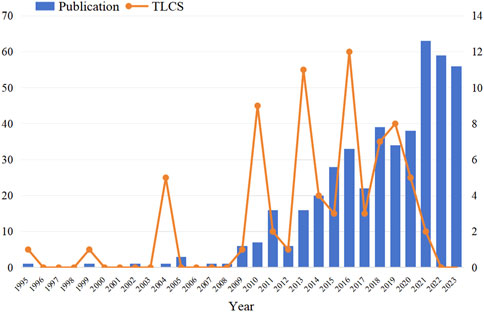
Figure 2. Publications and total local citation score over time. The variation of TLCS in this field is not increase steadily. The TLCS achieved 5 times during the period covered by our study (in 2004, 2010, 2013, 2015 and 2019), suggesting that these were pivotal years in which seminal literature may have been published.
3.2 Distribution of countries/regions and institutions
Table 1 showed the top 10 most prolific countries and institutions in the field of clinical trials of metallic Nanomaterials for cancer treatment. The country with the highest number of publications was China (n = 157, 34.7%), followed by United States (n = 155, 34.3%) and the Germany (n = 24, 5.3%). According to the top 10 institutions in terms of publications in this field, Chinese Academy of Sciences (n = 17, 3.8%) had the highest number of publications during the study period, followed by the University of Texas MD Anderson Cancer Center (n = 12, 2.7%), Shanghai Jiaotong University (n = 9, 2%), and the University of Chicago (n = 9, 2%). In terms of the number of papers published, the top 10 countries/regions exceeded 90% of all the publications, suggesting that research in this area is unevenly developed among countries/regions.
Figure 3A shows the number of annual publications in the top 10 most productive countries, demonstrating a steady increase in the number of publications. Figure 3B shows the cooperation among countries and the lines between countries reflects the cooperation frequency among them. It is worth noting that the more frequent cooperation between countries, the more numerous and thicker of the lines. So we can obtain from diagram that China and the United States played important roles in the global transnational cooperation. This result is consistent with the previous results that China and the United States are the two most productive countries. Figure 3C shows a visual network diagram of cooperation between countries generated by VOSviewer. Since only countries with at least five publications were included in the analysis, and 21 countries met this criterion. Due to the existence of the same number of publications, there were 12 organizations in the top 10 prolific institutions. The largest number of institutions came from the United States, with six. Followed by China with three. And finally, one each from Italy, the United Kingdom and Saudi Arabia.
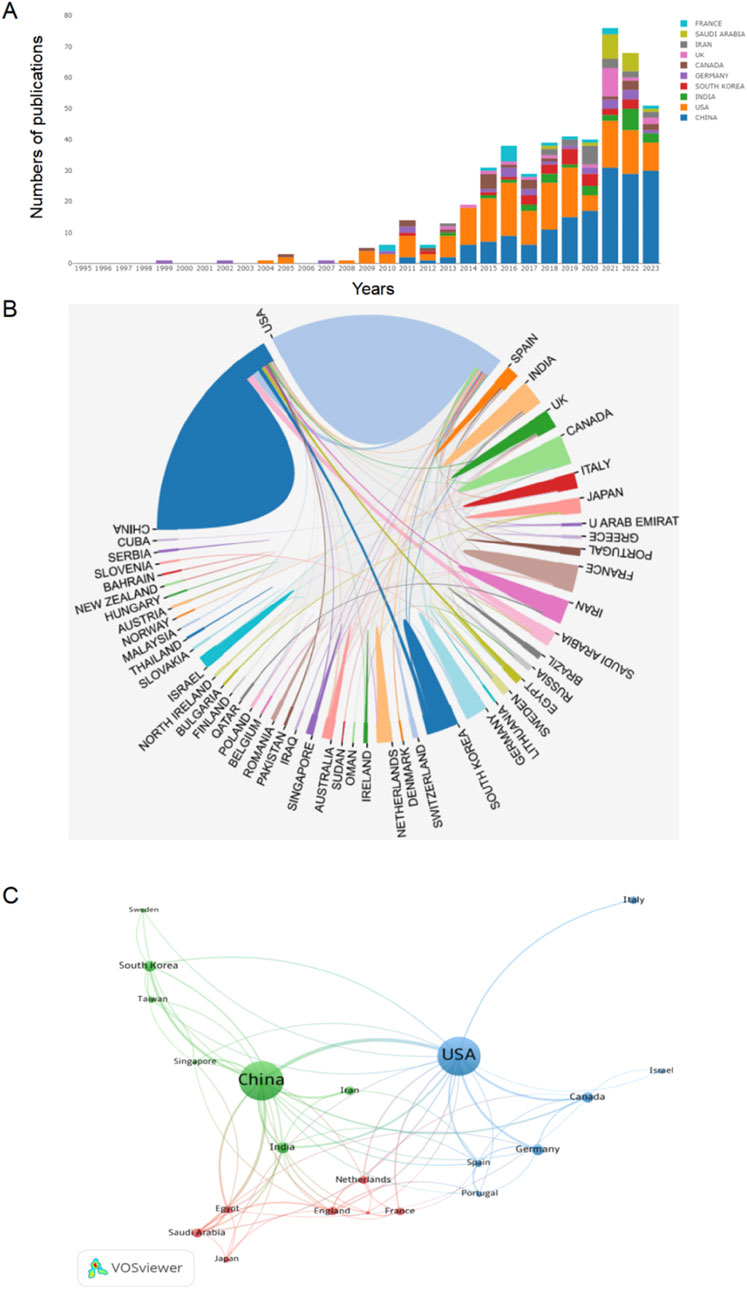
Figure 3. Analysis of clinical cancer therapy with metal Nanomaterials related countries/regions. (A) Annual publishing trends in the top 10 countries/regions from 1995 to 2023; (B) A visual map of international cooperation in countries/regions; (C) Network visualization showing relationships between countries/regions.
3.3 Distribution of authors
The high citation index (H-index) was introduced in 2005 by Jorge E. Hirsch from the University of California, San Diego, as a comprehensive quantitative metric to assess the academic achievements of researchers. A higher H-index indicates greater academic influence of the researcher (Schreiber and Giustini, 2019). The top 10 most productive authors who contributed to clinical trials of metallic Nanomaterials therapy for cancer were shown in Table 2. Because the presence of same number of publications, there were 14 person in the list of most prolific top 10 authors. They published a total of 83 papers accounting for 18.1% of all publications. Among them, Mohammad Mahdi Zangeneh had the highest number of research publications (n = 8, 1.8%), followed by Yu Liu (n = 7, 1.5%). Further analysis revealed that seven of the 14 authors were from China, followed by two authors each from Iran, the United States and France. One remaining author is from South Korea.
The minimum number of author publications was set to 1, and 150 authors were selected for the co-author analysis using VOSviewer. Figure 4A showed the network visualization by VOSviewer of these authors’ collaborative relationships. The nodes in the graphic represent authors, and lines between the nodes represent the collaborative relationships. The larger the number of publications, the larger the node area. Colors represent clusters automatically calculated by VOSviewer. The collaboration network of authors provides information for finding research partners and industry authorities. Francois Lux and Olivier Tillement are at the center of the collaborative network. Francois Lux is actively collaborating with Olivier Tillement, Lucle Sancey, Sandrine Dufort and so on, and the authors Olivier Tillement collaborated with mostly overlap with Francois Lux.
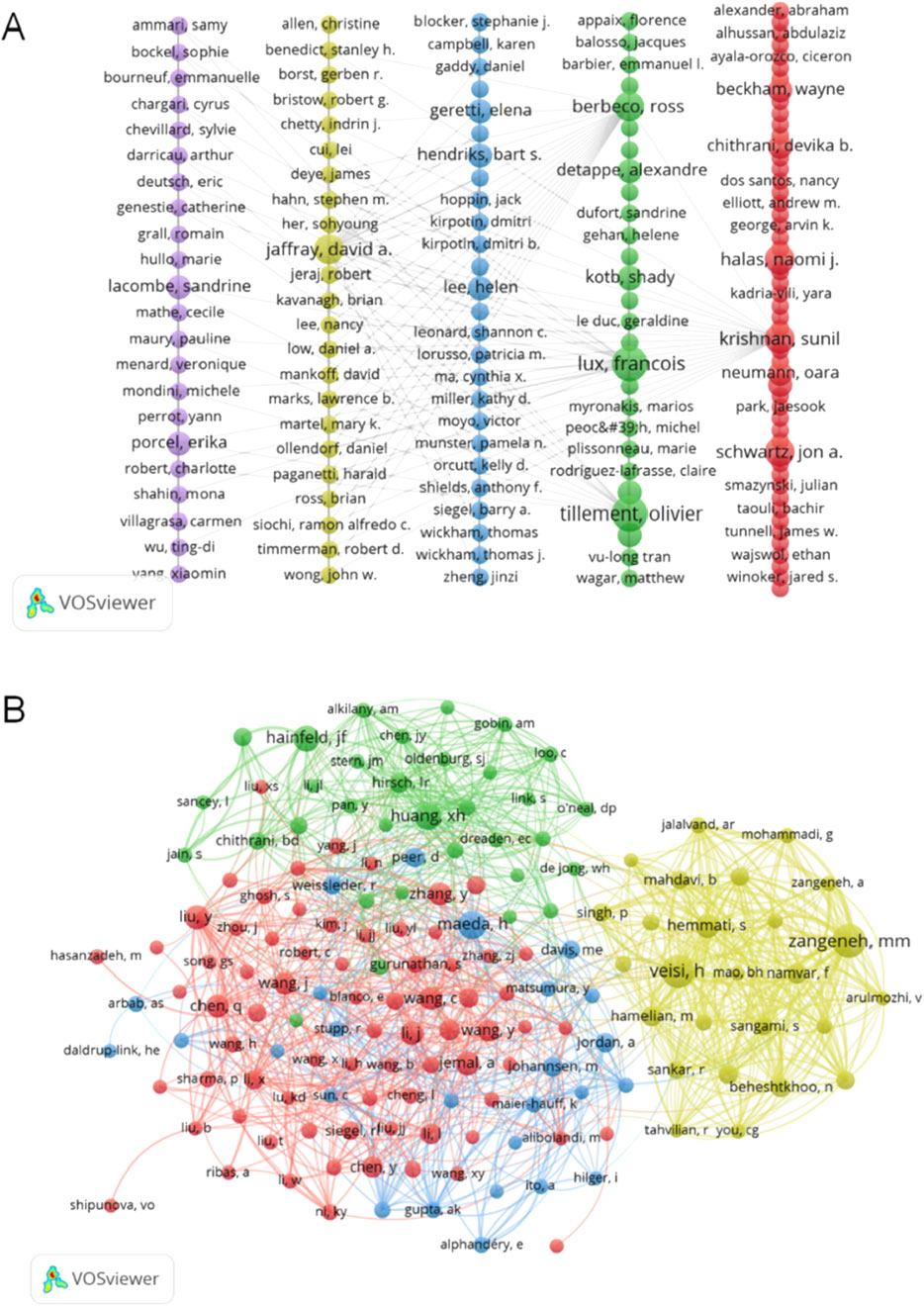
Figure 4. Analysis of clinical cancer therapy with metal Nanomaterials related author. (A) Visualization of cooperation network of authors with a minimum of one paper; (B) Visualization of co-cited authorship network map.
The co-cited authorship network map showed that the research focus of the authors of application of metal Nanomaterials in clinical trials for cancer treatment is highly homogeneous (Figure 4B).
3.4 Distribution of journals
Journal impact factor (IF) and Journal Citation Report (JCR) quartiles reflect the influence of journals. Journals with the top 25% (including 25%) of impact factors are located in the JCR quartile 1 (Q1), and journals with the top 25%–50% (including 50%) of impact factors are located in the JCR quartile 2 (Q2). Journal analysis can help find the core journals in this field (Brookes, 1969). The analysis revealed that 233 journals were involved in research on the application of metal Nanomaterials in clinical trials for cancer treatment during our study period. Table 3 showed the top 10 journals in the number of articles, corresponding IF (JCR 2024) and JCR quartile. Biomaterials published the largest number of publications (n = 13, 2.9%) on this topic. The 2024 impact factor of this journal was 12.8. It was followed closely by the Journal of the ACS Applied Materials and Interfaces (n = 12, 2.7%), Arabian Journal of Chemistry (n = 9, 2%), and the Clinical Cancer Research (n = 9, 2%). The journals with the highest TLCS were the Clinical Cancer Research (TLCS = 8), indicating that this journal was likely to be the definitive publications for the application of metal Nanomaterials in clinical trials for cancer treatment. What’s more, among the top 10 journals in co-citation frequency, nine journals are distributed in JCR Q1 and four journals have an IF over 10.
The network diagram of cited journals (Figure 5) represents the degree of association between journals. The journal clustering is divided into five clusters. The size of the node represents the co-citation frequency, and the thickness of the connection represents the correlation strength. The themes of journals of the same color are similar, and the red cluster centered on cancer research is the most representative, indicating that the degree of topic connection between journals is the strongest and the number of common references is the largest.
3.5 Highly cited reference analysis
By analyzing the most cited articles in this field, the center and focus of research can be identified, thereby assisting beginners in the field to quickly understand the research process and direction. Table 4 listed the top 10 most cited publications, among which the study entitled “Magnetic fluid hyperthermia (MFH): Cancer treatment with AC magnetic field induced excitation of biocompatible superparamagnetic nanoparticles” by Manfred Johannsen et al. was the most cited (n = 1,244). In 2005, Johannsen et al. used a mouse prostate tumor model to study the therapeutic effect of magnetic fluid hyperthermia. The results show that the maximum temperature in the tumor can reach more than 70°C when the frequency is 100 kHz and the magnetic field intensity is 18 kA/m. When the magnetic field intensity is 12.6 kA/m, the average maximum temperature inside the tumor is 54.8°C, and the minimum temperature is 41.28°C. Compared with the tumor weight of the treatment group and the control group, the inhibitory effect of magnetic fluid hyperthermia on tumor growth was 44% ∼ 51% (Johannsen et al., 2005). This study achieved a major breakthrough in the application of metal Nanomaterials in tumor therapy from theory to animal in vivo verification.
Article co-citation analysis analyzes the relationship between articles by analyzing the co-citation frequency of the articles. The relationship between studies is presented using VOSviewer in Figure 6. This network consists of 184 nodes (representing authors of literature) and 2,988 links (representing citation relationships among these nodes), with a threshold of 5.
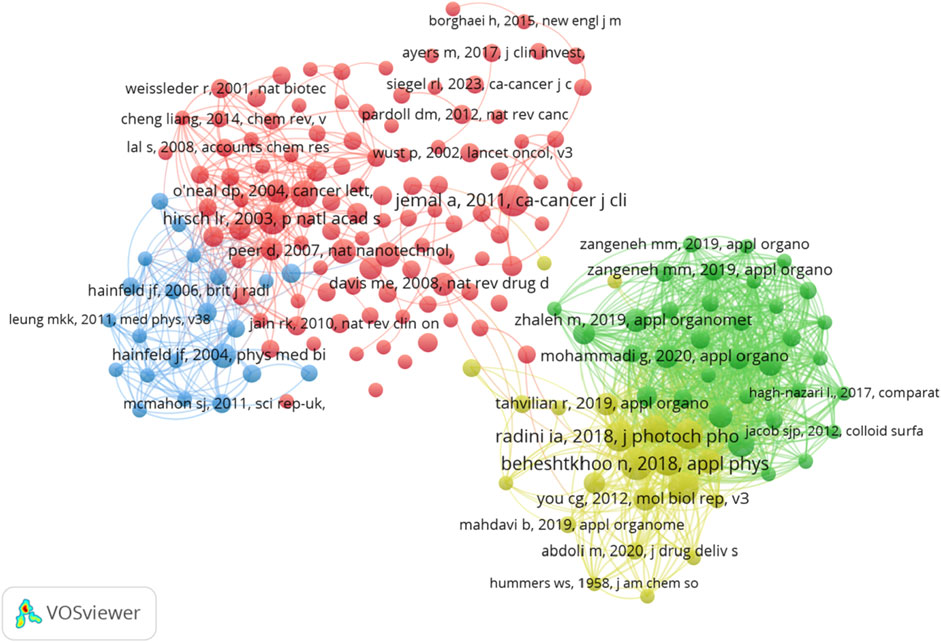
Figure 6. Visualization of the highly cited references in the clinical cancer therapy with Nanomaterials.
3.6 Keywords analysis
As an overview of the core content of the article, keyword analysis was performed to determine the hotspots of clinical cancer treatment with metal Nanomaterials research. Table 5 shows the top 20 keywords by frequency. The most frequently occurring keyword is “nanoparticles” (n = 75), followed by “cancer” (n = 67). In addition, “therapy” (n = 60) and “gold nanoparticles” (n = 54) are frequent keywords, indicating that their corresponding fields are popular in metal Nanomaterials clinical cancer research. After removing non-informative keywords, we constructed a network comprising 147 keywords that appeared at least 5 times in VOSviewer, resulting in five distinct clusters (Figure 7A). The first group (red) included 32 keywords, such as chemotherapy, expression, resistance, safety, solid tumors and toxicity. The second group (green) included 28 keywords, such as delivery, ablation, mechanism, apoptosis and hyperthermia. The third group (blue) included 28 keywords, such as cellular uptake, receptors, mri, survival and gold nanoparticles. The fourth group (yellow) included 22 keywords, such as activation, blockade, radiation, iron and t-cells. The fifth group (purple) included 21 keywords, such as acid, biosynthesis, cytotoxicity, green synthesis and immune-response. The sixth group (cyan) included 16 keywords, such as micelles, liposomes, oxide, strategies and co-delivery.
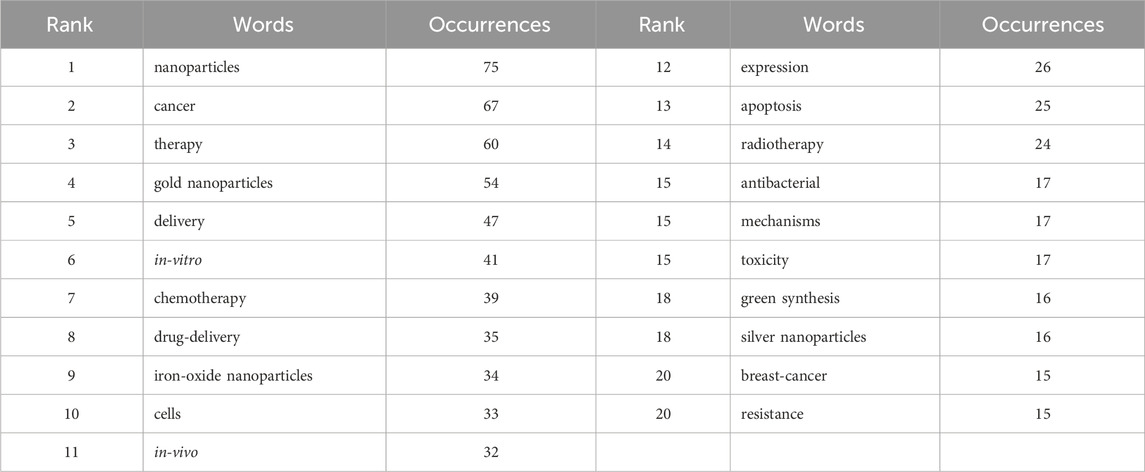
Table 5. Top 20 keywords in terms of frequency regarding clinical cancer therapy with metal Nanomaterials.
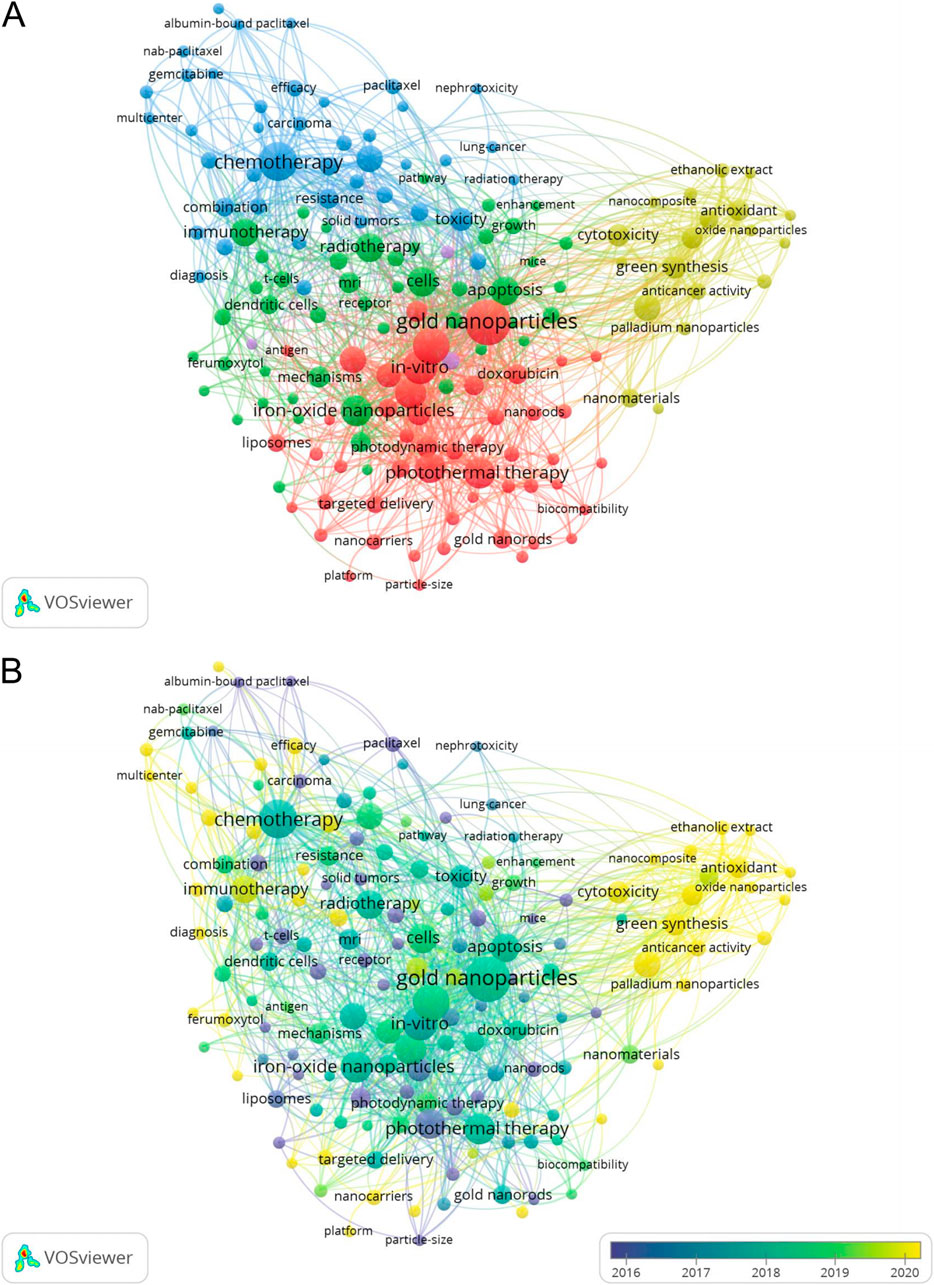
Figure 7. Analysis of clinical cancer therapy with metal Nanomaterials related keywords. (A) Visualization of keywords network with occurrences of at least 5; (B) Visualization of keywords co-occurrence network over time.
Figure 7B presents a superimposed visualization of keywords, showing the changes that took place in terms of the keywords used over time. Purple nodes indicate early hotspots, while yellow nodes indicate emerging hotspots. The keywords gradually changed from “drug-delivery,” “hyperthermia,”“liposomes,” and “antitumor-activity” to “multicenter” and “safety,”“tumor microenvironment,”“antibacterials,” and “green synthesis.”
Figure 8 further displayed annual keywords mutations, facilitating a better understanding of annual hot topics and serving as a reference for future industry research and development based on recent keyword shifts.
4 Discussion
This study represents the bibliometric analysis of clinical cancer treatment with metal Nanomaterials that has been implemented to date between 1995 and 2023. This study mainly used Bibliometrix Online Analysis Platform, HistCite, VOSviewer and Bibliometrix (R-Tool of R-Studio) to analyze 452 articles selected from the Web of Science Core Collection. These analyses included the number of annual global publications and TLCS focusing on clinical treatment with metal Nanomaterials, the countries or regions where these publications originated, the distribution of authors, the distribution of journals, highly cited reference and keywords analysis. Together, this contributed to our in-depth analysis of the research hotspots and future development trends in the field of clinical cancer treatment with metal Nanomaterials.
4.1 General information study
Over the past 2 decades, publications in the field of clinical cancer treatment with metal Nanomaterials have shown a steady upward trend (mainly divided into three phases), which began to plateau after a surge in 2009 and 2021, respectively. In the first stage, there are few tools and methods to effectively synthesize and test nanoparticles, and there are few high-impact studies. In addition, the scientific community is still exploring the potential applications of nanomaterials in medicine, resulting in fewer publications and citations. The prosperous of this field in 2009 can be attributed to several factors. First, technological advances during this period led to better control over the size, shape and surface modification of nanoparticles, which made them more effective in cancer treatment (Gül et al., 2024). Secondly, metal nanomaterials have begun to be used for multifunctional therapy, combining drug delivery and imaging, which has attracted more research attention (Hheidari et al., 2024). Third, initiatives like the U.S. National Nanotechnology Initiative (NNI) provided significant funding, which facilitated extensive research and clinical trials in nanotechnology applications, including drug delivery (Foundation, 2020). may be related to the huge success of the first phase of the world’s first clinical trial of a drug based on metal Nanomaterials. The sudden increase in the number of publications in 2022 may be related to the CE approval of crystalline hafnium oxide nanoparticle (Anselmo and Mitragotri, 2019). And the number of publications peaked in this year, which indicated a growing interest in Nanomaterials among clinical cancer trial practitioners.
From a country or regional perspective, the top three most productive countries in the field of metal Nanomaterials clinical cancer trials are China, the United States, and the Germany, with these three countries also contributing the most to the TLCS. It is worth noting that although China ranks first in terms of publications, its TLCS was far less than the USA. This indicates that although China is leading in production, the influence and impact of its research—reflected by citations within the local research community—is not as strong as that of the United States in the metal Nanomaterials field. The reasons for this phenomenon are usually related to different levels of research innovation, funding and cooperation networks. The United States has traditionally invested heavily in cutting-edge biomedical research, resulting in higher-impact research that sets global benchmarks (Owens, 2014). In addition, strong academic and industry partnerships in the United States often make it easier for research to be applied or referenced in subsequent research (Vico and Hallonsten, 2019). Another contributing factor is the difference in international cooperation models. Studies have shown that studies with high levels of international cooperation tend to receive more citations, and the United States often participates in a wide range of global cooperation, especially with top institutions in Europe and other regions (Grubbs et al., 2019). In contrast, Chinese research may focus more on regions, limiting its exposure to a global academic audience, thereby reducing the potential for citation (Han et al., 2024). In order to improve the citation potential of papers, Chinese scientific research institutions should focus on improving the quality of papers and encouraging innovative research with high influence. This can be achieved by increasing funding for cutting-edge research projects and supporting interdisciplinary projects that advance the boundaries of scientific knowledge (Lauer, 2022). Clinicians in China should pay close attention to current research hotspots, while also placing additional importance on ongoing scientific innovation, and expanding participation in international research networks to improve the global visibility and citation impact of Chinese research (Gao et al., 2022). Of the 10 most productive institutions, the top five are from China, followed by the United States and Italy. Among them, China and the United States are also notably the top two countries in terms of publications contribution, which clearly demonstrates that establishing world-class academic institutions is key to solving any existing imbalance in resource development. The presence of such institutions can also improve a country’s scientific research, innovation ability, and academic status.
Of the top 10 most prolific authors, Zangeneh Mohammad Mahdi has been the author that has made the most contributions in the field of metal Nanomaterials cancer clinical trials. Zangeneh Mohammad Mahdi is a member of the Ilam University of Medical Sciences, whose team focuses on research in metal Nanomaterials, particularly in the green synthesis of metal Nanomaterials. Zangeneh Mohammad Mahdi had involved in several clinical trials for metal Nanomaterials (Nejad et al., 2024b; Dou et al., 2021; Li et al., 2020; Sun et al., 2020; Nejad et al., 2024a). At the same time, his H-index is also high, ranking fourth in the field. On the whole, he has made outstanding contributions to the development of this field to a certain extent. It is worth noting that his main research direction is not the clinical treatment of cancer by metal Nanomaterials, but chemical synthesis, but he does rank first in the number of papers published in the field of clinical cancer treatment by metal Nanomaterials. This suggests a lack of researchers in the field of clinical cancer therapy where metal Nanomaterials may exist, or a insufficient number of publications by researchers specializing in this field. One of the reasons for this phenomenon may be related to the difficulty in obtaining regulatory approval for the use of metal Nanomaterials for therapeutic applications, which requires extensive preclinical and clinical studies to evaluate their safety and efficacy (Baranwal et al., 2023). Therefore, in order to achieve earlier real application of metal Nanomaterials in clinical cancer treatment, it is crucial to narrow the gap between laboratory research and its use in clinical settings. Another reason may be the lack of research funding to support this area, which leads to difficulties in conducting relevant clinical studies (Ventola, 2017). Therefore, we believe that in order to promote the development of this research field, policy support and related funding support at the government level are necessary.
An analysis of journals and co-cited journals can provide a reliable reference source for researchers’ contributions (Garfield, 1999). Of the top 10 most productive journals, Biomaterials and ACS Applied Materials and Interfaces are the two most productive specialized journals in the field of clinical cancer treatment with metal Nanomaterials. In particular, the TLCS of Biomaterials were also at a high level. The journal also has an excellent IF, ranking second among the top 10 most productive journals.
4.2 Research hotspots and development trends of metal nanomaterials in clinical cancer trials
The top 10 cited references in cancer metal Nanomaterials treatment were published in high-impact journals, with many authored by the world’s leading research teams. As seen in several studies, such as those conducted by teams focused on magnetic nanoparticles for cancer hyperthermia (Johannsen et al., 2005; Maier-Hauff et al., 2011), it has shown the potential to target and destroy cancer cells with minimal damage to surrounding healthy tissues. Recent clinical trials have shown that metal nanoparticles, such as gold nanoparticles and iron nanoparticles, have significant efficacy in improving cancer treatment. For example, clinical trials of iron nanoparticles synthesized by green synthesis have shown significant cytotoxic effects on colon cancer cells, especially when combined with radiotherapy (Nejad et al., 2024a). The progress of these studies emphasizes that nanoparticle-based therapies are increasingly developing into the field of clinical transformation, further advancing their potential for extensive medical applications. It can be seen from the highly cited articles that there has been some improvement in this research field and some high-quality research has probably begun around 2000. For example, gold nanoparticles as vectors for drug delivery were highlighted in the 2004 Drug Delivery article (Paciotti et al., 2004), laying the foundation for targeted drug delivery systems. Studies on biohybrid microrobots for imaging-guided therapy (Yan et al., 2017) also reflect a shift towards multifunctional treatments combining diagnostics and therapy. These early-stage trials have been crucial in advancing nanoparticle-based technologies toward clinical applications. More recent work, such as the 2017 Nature Materials article on designer vaccine nanodiscs for personalized immunotherapy (Kuai et al., 2017), demonstrates the growing interest in personalized cancer treatment approaches, offering alternatives to traditional methods. This collection of highly cited articles reflects a strong emphasis on clinical translation, with many studies forming the basis for future therapeutic advancements in the nanomedicine field.
Keywords are essential for identifying key articles and conducting a comprehensive analysis in any research field. They represent the core themes of the articles and reflect the prominent research hotspots. In this analysis of clinical cancer therapy using Nanomaterials, the evolution of keywords over time, visualized through overlay mapping, reveals important trends and shifts in focus, guiding future research directions. It can be seen from Table 5 that “nanoparticles”, “cancer” and “treatment” are the most frequently used keywords, indicating that they occupy the central position of the top 20 keywords in nanoparticle-based cancer treatment (Lim et al., 2015). The keywords “gold nanoparticles” and “iron-oxide nanoparticles” reflect the specific materials that are frequently employed, as seen in the most-cited articles on photothermal therapy (Huang et al., 2008) and drug delivery systems (Gupta and Gupta, 2005). This focus on nanoparticles, particularly gold and iron-oxide variants, aligns with the broader trend towards enhancing targeted therapy and reducing side effects. The emergence of terms like “green synthesis” and “antioxidant” in recent years also highlights a growing interest in sustainable and biocompatible methods for nanoparticle production, which has significant implications for clinical applications (Hawadak et al., 2022). Despite advances in research in the field of green synthesis, there are still challenges in expanding these green synthetic methods for clinical applications. Unlike traditional chemical synthesis methods, green synthesis often faces problems related to reproducibility, particle stability, and control of size and shape, especially in large-scale production. In addition, raw materials such as plant extracts introduce variability, which complicates quality control and makes it difficult to maintain consistency in large-scale production (Holghoomi et al., 2024). Although traditional methods provide better scalability and precision, they often involve toxic chemicals and produce harmful by-products, making them less suitable for clinical applications. In contrast, although green synthesis is environmentally friendly, it needs to be further improved in terms of cost-effectiveness, repeatability and scalability to meet the needs of clinical production (Kandav and Sharma, 2024).
The network visualizations (Figure 7) show the co-occurrence of keywords, with colored clusters representing different research areas. In the Figure 7A diagram, “gold nanoparticles” appears at the center of the red cluster, connected to terms like “photothermal therapy”, “iron-oxide nanoparticles”, and “drug delivery”. This suggests a focus on combining Nanomaterials with thermal-based therapies and delivery systems (Jain et al., 2008). The blue cluster is dominated by terms related to “chemotherapy” and “immunotherapy”, indicating their frequent pairing with Nanomaterials research (Torchilin, 2014). The green and yellow clusters cover more specific areas like “green synthesis” and “cytotoxicity”, pointing to increasing research on environmentally friendly synthesis methods and the safety of Nanomaterials (Torchilin, 2014). The timeline in Figure 7B indicates how these keywords evolved, with keywords related to “green synthesis” and “antioxidant” becoming more prominent in recent years (shown in yellow), signaling a growing interest in sustainable and biocompatible Nanomaterials applications (González-Ballesteros et al., 2017).
This analysis shows that metal Nanobiomaterials, especially gold and iron-oxide varieties, are at the forefront of cancer therapy research, with a strong focus on drug delivery, chemotherapy, and radiotherapy applications. The trend toward sustainable and biocompatible methods, such as green synthesis, is also gaining momentum.
5 Limitation
Although we have perfected this study as much as possible, this study still has some inevitable limitations. First of all, although Web of Science is one of the most authoritative literature retrieval tools, it does not cover all the literature related to this study. In addition, we only search for articles in English and ignore articles in other languages, which may lead to deviations in the results. Lastly, although our search strategy was designed to be comprehensive, it is possible that other relevant keywords were overlooked which could affect our results.
6 Conclusion
To the best of our knowledge, this study represents the first bibliometric analysis in the field of clinical cancer treatment with metal Nanomaterials. It identifies current research hotspots and directions in this field, and aims to predict future research developments, which may provide valuable information for future clinicians. Future research should focus on validating the clinical efficacy and safety of metal Nanobiomaterials for cancer treatment, especially in personalized medicine and photodynamic therapy.
Author contributions
ZY: Conceptualization, Data curation, Investigation, Methodology, Software, Supervision, Writing–original draft. JW: Formal Analysis, Funding acquisition, Project administration, Resources, Validation, Visualization, Writing–review and editing.
Funding
The author(s) declare that no financial support was received for the research, authorship, and/or publication of this article.
Conflict of interest
The authors declare that the research was conducted in the absence of any commercial or financial relationships that could be construed as a potential conflict of interest.
Generative AI statement
The author(s) declare that no Generative AI was used in the creation of this manuscript.
Publisher’s note
All claims expressed in this article are solely those of the authors and do not necessarily represent those of their affiliated organizations, or those of the publisher, the editors and the reviewers. Any product that may be evaluated in this article, or claim that may be made by its manufacturer, is not guaranteed or endorsed by the publisher.
References
Anselmo, A. C., and Mitragotri, S. (2019). Nanoparticles in the clinic: an update. Bioeng. Transl. Med. 4 (3), e10143. doi:10.1002/btm2.10143
Aria, M., Cuccurullo, C., and Egghe, L. (2017). Bibliometrix: an R-tool for comprehensive science mapping analysis. J. Informetr. 11, 959–975. doi:10.1016/j.joi.2017.08.007
Baranwal, J., Barse, B., Di Petrillo, A., Gatto, G., Pilia, L., and Kumar, A. (2023). Nanoparticles in cancer diagnosis and treatment. Mater. (Basel) 16 (15), 5354. doi:10.3390/ma16155354
Bloise, N., Strada, S., Dacarro, G., and Visai, L. (2022). Gold nanoparticles contact with cancer cell: a brief update. Int. J. Mol. Sci. 23 (14), 7683. doi:10.3390/ijms23147683
Bray, F., Laversanne, M., Weiderpass, E., and Soerjomataram, I. (2021). The ever-increasing importance of cancer as a leading cause of premature death worldwide. Cancer 127 (16), 3029–3030. doi:10.1002/cncr.33587
Brookes, B. C. (1969). Bradford's law and the bibliography of science. Nature 224 (5223), 953–956. doi:10.1038/224953a0
Chen, S., Cao, Z., Prettner, K., Kuhn, M., Yang, J., Jiao, L., et al. (2023). Estimates and projections of the global economic cost of 29 cancers in 204 countries and territories from 2020 to 2050. JAMA Oncol. 9 (4), 465–472. doi:10.1001/jamaoncol.2022.7826
Dou, L., Zhang, X., Zangeneh, M. M., and Zhang, Y. (2021). Efficient biogenesis of Cu(2)O nanoparticles using extract of Camellia sinensis leaf: evaluation of catalytic, cytotoxicity, antioxidant, and anti-human ovarian cancer properties. Bioorg Chem. 106, 104468. doi:10.1016/j.bioorg.2020.104468
Eck, N. J. P. V. (2009). J ERIM Report series research in management waltman. VOSviewer A Comput. Program Bibliometric Mapp. 84 (2), 523–538.
El Hallal, R., Lyu, N., and Wang, Y. (2021). Effect of cetuximab-conjugated gold nanoparticles on the cytotoxicity and phenotypic evolution of colorectal cancer cells. Molecules 26 (3), 567. doi:10.3390/molecules26030567
Farah, M. A., Ali, M. A., Chen, S. M., Li, Y., Al-Hemaid, F. M., Abou-Tarboush, F. M., et al. (2016). Silver nanoparticles synthesized from Adenium obesum leaf extract induced DNA damage, apoptosis and autophagy via generation of reactive oxygen species. Colloids Surf. B Biointerfaces 141, 158–169. doi:10.1016/j.colsurfb.2016.01.027
Foundation, N. S. (2020). National nanotechnology initiative at 20 Years: progress and achievements. Available at: https://www.nsf.gov.
Gao, Y. R., Lin, R. H., and Lu, Y. H. (2022). A visualized analysis of the research current hotspots and trends on innovation chain based on the knowledge map. Sustainability 14 (3), 1708. doi:10.3390/su14031708
Garfield, E., Paris, S. W., and Stock, G. W. (2006). “HistCite: a software tool for informetric analysis of citation linkage” 57 (8):391–400.
González-Ballesteros, N., Prado-López, S., Rodríguez-González, J. B., Lastra, M., and Rodríguez-Argüelles, M. C. (2017). Green synthesis of gold nanoparticles using brown algae Cystoseira baccata: its activity in colon cancer cells. Colloids Surf. B Biointerfaces 153, 190–198. doi:10.1016/j.colsurfb.2017.02.020
Grubbs, J. C., Glass, R. I., and Kilmarx, P. H. (2019). Coauthor country affiliations in international collaborative research funded by the US national institutes of health, 2009 to 2017. JAMA Netw. Open 2 (11), e1915989. doi:10.1001/jamanetworkopen.2019.15989
Gül, D., Acet, B. Ö., Lu, Q., Stauber, R. H., Odabasi, M., and Acet, Ö. (2024). Revolution in cancer treatment: how are intelligently designed nanostructures changing the game? Int. J. Mol. Sci. 25 (10), 5171. doi:10.3390/ijms25105171
Gupta, A. K., and Gupta, M. (2005). Synthesis and surface engineering of iron oxide nanoparticles for biomedical applications. Biomaterials 26 (18), 3995–4021. doi:10.1016/j.biomaterials.2004.10.012
Han, L. L., Shan, Z. D., Lei, M., and Long, S. W. (2024). A comparative study of international and Chinese digitization from the perspective of mapping knowledge domains. Int. Rev. Econ. and Finance 89, 93–113. doi:10.1016/j.iref.2023.09.015
Hawadak, J., Kojom Foko, L. P., Pande, V., and Singh, V. (2022). In vitro antiplasmodial activity, hemocompatibility and temporal stability of Azadirachta indica silver nanoparticles. Artif. Cells Nanomed Biotechnol. 50 (1), 286–300. doi:10.1080/21691401.2022.2126979
Hheidari, A., Mohammadi, J., Ghodousi, M., Mahmoodi, M., Ebrahimi, S., Pishbin, E., et al. (2024). Metal-based nanoparticle in cancer treatment: lessons learned and challenges. Front. Bioeng. Biotechnol. 12, 1436297. doi:10.3389/fbioe.2024.1436297
Holghoomi, R., Kharab, Z., Rahdar, A., Pandey, S., and Ferreira, L. F. R. (2024). Harnessing the power of green synthesis of nanomaterials for anticancer applications: a review. Coord. Chem. Rev. 513, 215903. doi:10.1016/j.ccr.2024.215903
Huang, X., Jain, P. K., El-Sayed, I. H., and El-Sayed, M. A. (2008). Plasmonic photothermal therapy (PPTT) using gold nanoparticles. Lasers Med. Sci. 23 (3), 217–228. doi:10.1007/s10103-007-0470-x
Jain, P. K., Huang, X., El-Sayed, I. H., and El-Sayed, M. A. (2008). Noble metals on the nanoscale: optical and photothermal properties and some applications in imaging, sensing, biology, and medicine. Acc. Chem. Res. 41 (12), 1578–1586. doi:10.1021/ar7002804
Jin, H., Yang, P., Cai, J., Wang, J., and Liu, M. (2012). Photothermal effects of folate-conjugated Au nanorods on HepG2 cells. Appl. Microbiol. Biotechnol. 94 (5), 1199–1208. doi:10.1007/s00253-012-3935-1
Johannsen, M., Thiesen, B., Jordan, A., Taymoorian, K., Gneveckow, U., Waldöfner, N., et al. (2005). Magnetic fluid hyperthermia (MFH)reduces prostate cancer growth in the orthotopic Dunning R3327 rat model. Prostate 64 (3), 283–292. doi:10.1002/pros.20213
Kandav, G., and Sharma, T. (2024). Green synthesis: an eco friendly approach for metallic nanoparticles synthesis. Part. Sci. Technol. 42 (5), 874–894. doi:10.1080/02726351.2023.2281452
Kuai, R., Ochyl, L. J., Bahjat, K. S., Schwendeman, A., and Moon, J. J. (2017). Designer vaccine nanodiscs for personalized cancer immunotherapy. Nat. Mater 16 (4), 489–496. doi:10.1038/nmat4822
Lauer, M. S. (2022). From hype to high-quality research. JAMA Netw. Open 5 (8), e2228683. doi:10.1001/jamanetworkopen.2022.28683
Li, Y., Li, N., Jiang, W., Ma, G., and Zangeneh, M. M. (2020). In situ decorated Au NPs on pectin-modified Fe(3)O(4) NPs as a novel magnetic nanocomposite (Fe(3)O(4)/Pectin/Au) for catalytic reduction of nitroarenes and investigation of its anti-human lung cancer activities. Int. J. Biol. Macromol. 163, 2162–2171. doi:10.1016/j.ijbiomac.2020.09.102
Lim, E. K., Kim, T., Paik, S., Haam, S., Huh, Y. M., and Lee, K. (2015). Nanomaterials for theranostics: recent advances and future challenges. Chem. Rev. 115 (1), 327–394. doi:10.1021/cr300213b
Maier-Hauff, K., Ulrich, F., Nestler, D., Niehoff, H., Wust, P., Thiesen, B., et al. (2011). Efficacy and safety of intratumoral thermotherapy using magnetic iron-oxide nanoparticles combined with external beam radiotherapy on patients with recurrent glioblastoma multiforme. J. Neurooncol 103 (2), 317–324. doi:10.1007/s11060-010-0389-0
Nejad, F. S., Alizade-Harakiyan, M., Haghi, M., Ebrahimi, R., Zangeneh, M. M., Farajollahi, A., et al. (2024a). Investigating the effectiveness of iron nanoparticles synthesized by green synthesis method in chemoradiotherapy of colon cancer. Heliyon 10 (7), e28343. doi:10.1016/j.heliyon.2024.e28343
Nejad, F. S., Alizade-Harakiyan, M., Haghi, M., Ebrahimi, R., Zangeneh, M. M., Farajollahi, A., et al. (2024b). Investigation of the impact of copper nanoparticles coated with ocimum bassilicum at chemoradiotherapy of colon carcinoma. Biochem. Biophys. Rep. 39, 101780. doi:10.1016/j.bbrep.2024.101780
Ninkov, A., Frank, J. R., and Maggio, L. A. (2022). Bibliometrics: methods for studying academic publishing. Perspect. Med. Educ. 11 (3), 173–176. doi:10.1007/s40037-021-00695-4
Núñez, R., Allen, M., Gao, R., Miller Rigoli, C., Relaford-Doyle, J., and Semenuks, A. (2019). What happened to cognitive science? Nat. Hum. Behav. 3 (8), 782–791. doi:10.1038/s41562-019-0626-2
Oladipo, A. O., Unuofin, J. O., Lebelo, S. L., and Msagati, T. A. M. (2022). Phytochemical-stabilized platinum-decorated silver nanocubes INHIBIT adenocarcinoma cells and enhance antioxidant effects by promoting apoptosis via cell cycle arrest. Pharmaceutics 14 (11), 2541. doi:10.3390/pharmaceutics14112541
Owens, B. (2014). Mapping biomedical research in the USA. Lancet 384 (9937), 11–14. doi:10.1016/s0140-6736(14)61114-4
Paciotti, G. F., Myer, L., Weinreich, D., Goia, D., Pavel, N., McLaughlin, R. E., et al. (2004). Colloidal gold: a novel nanoparticle vector for tumor directed drug delivery. Drug Deliv. 11 (3), 169–183. doi:10.1080/10717540490433895
Rytov, R. A., Bautin, V. A., and Usov, N. A. (2022). Towards optimal thermal distribution in magnetic hyperthermia. Sci. Rep. 12 (1), 3023. doi:10.1038/s41598-022-07062-1
Sanpui, P., Chattopadhyay, A., and Ghosh, S. S. (2011). Induction of apoptosis in cancer cells at low silver nanoparticle concentrations using chitosan nanocarrier. ACS Appl. Mater Interfaces 3 (2), 218–228. doi:10.1021/am100840c
Schreiber, W. E., and Giustini, D. M. (2019). Measuring scientific impact with the h-index: a primer for pathologists. Am. J. Clin. Pathol. 151 (3), 286–291. doi:10.1093/ajcp/aqy137
Shi, J., Kantoff, P. W., Wooster, R., and Farokhzad, O. C. (2017). Cancer nanomedicine: progress, challenges and opportunities. Nat. Rev. Cancer 17 (1), 20–37. doi:10.1038/nrc.2016.108
Siddique, S., and Chow, J. C. L. (2022). Recent advances in functionalized nanoparticles in cancer theranostics. Nanomater. (Basel) 12 (16), 2826. doi:10.3390/nano12162826
Sun, T., Gao, J., Shi, H., Han, D., Zangeneh, M. M., Liu, N., et al. (2020). Decorated Au NPs on agar modified Fe(3)O(4) NPs: investigation of its catalytic performance in the degradation of methylene orange, and anti-human breast carcinoma properties. Int. J. Biol. Macromol. 165 (Pt A), 787–795. doi:10.1016/j.ijbiomac.2020.09.157
Sung, H., Ferlay, J., Siegel, R. L., Laversanne, M., Soerjomataram, I., Jemal, A., et al. (2021). Global cancer statistics 2020: GLOBOCAN estimates of incidence and mortality worldwide for 36 cancers in 185 countries. CA Cancer J. Clin. 71 (3), 209–249. doi:10.3322/caac.21660
Torchilin, V. P. (2014). Multifunctional, stimuli-sensitive nanoparticulate systems for drug delivery. Nat. Rev. Drug Discov. 13 (11), 813–827. doi:10.1038/nrd4333
Torre, L. A., Bray, F., Siegel, R. L., Ferlay, J., Lortet-Tieulent, J., and Jemal, A. (2015). Global cancer statistics, 2012. CA Cancer J. Clin. 65 (2), 87–108. doi:10.3322/caac.21262
van Eck, N. J., and Waltman, L. (2010). Software survey: VOSviewer, a computer program for bibliometric mapping. Scientometrics 84 (2), 523–538. doi:10.1007/s11192-009-0146-3
Ventola, C. L. (2017). Progress in nanomedicine: approved and investigational Nanodrugs. P t 42 (12), 742–755.
Vico, E. P., and Hallonsten, O. (2019). “How industry collaboration influences research: the case of the Swedish interdisciplinary materials consortia” Indu. and High. Edu. 33 (5):289–307.
Villalobos Gutiérrez, P. T., Muñoz Carrillo, J. L., Sandoval Salazar, C., Viveros Paredes, J. M., and Gutiérrez Coronado, O. (2023). Functionalized metal nanoparticles in cancer therapy. Pharmaceutics 15 (7), 1932. doi:10.3390/pharmaceutics15071932
Xu, J. J., Zhang, W. C., Guo, Y. W., Chen, X. Y., and Zhang, Y. N. (2022). Metal nanoparticles as a promising technology in targeted cancer treatment. Drug Deliv. 29 (1), 664–678. doi:10.1080/10717544.2022.2039804
Xu, Z., Qu, H., Ren, Y., Gong, Z., Ri, H. J., Zhang, F., et al. (2021). Update on the COVID-19 vaccine research trends: a bibliometric analysis. Infect. Drug Resist 14, 4237–4247. doi:10.2147/idr.S335745
Keywords: biomaterials, nanodrugs, nanomaterials, cancer therapy, nano
Citation: Yun Z and Wei J (2024) Trends in the application of metal Nanobiomaterials in cancer therapy clinical trials. Front. Nanotechnol. 6:1507484. doi: 10.3389/fnano.2024.1507484
Received: 10 October 2024; Accepted: 07 November 2024;
Published: 20 November 2024.
Edited by:
Junjie Cheng, University of Science and Technology of China, ChinaCopyright © 2024 Yun and Wei. This is an open-access article distributed under the terms of the Creative Commons Attribution License (CC BY). The use, distribution or reproduction in other forums is permitted, provided the original author(s) and the copyright owner(s) are credited and that the original publication in this journal is cited, in accordance with accepted academic practice. No use, distribution or reproduction is permitted which does not comply with these terms.
*Correspondence: Junfan Wei, d2VpanVuZmFuMTIzNDU2QDE2My5jb20=
 Zhengcheng Yun
Zhengcheng Yun Junfan Wei
Junfan Wei